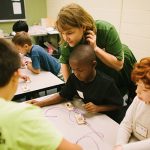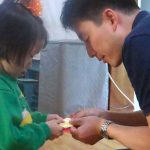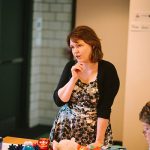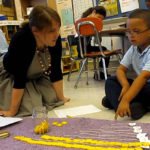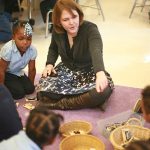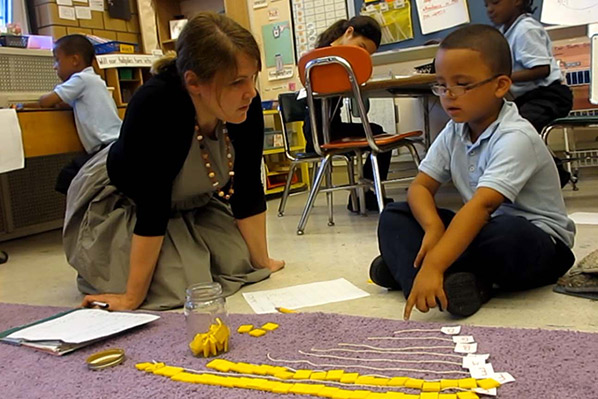
The Children’s Innovation Project: a tale of one classroom
The Children’s Innovation Project
When Junlei Li entered Melissa Butler’s kindergarten class in spring 2012 with a video camera, Butler didn’t realize Li was focusing his lens mostly on her.
Butler had been teaching for 16 years by then, and in Pittsburgh Allegheny K–5 since 2008. Li’s project, Something Worth Giving, funded by the Grable Foundation, was trying to figure out what actions really help children in the many places they go, including classrooms. His job was to see what Butler gave to her class, and what worked for her students. He filmed inside her room two to three times a week over a four-week period.
“Her classroom, her school – on the surface they looked quite ordinary,” he recalls. “But once we were inside her classroom it was quite remarkable.”
“He has a very quiet presence,” Butler remembers. “He was just noticing… I noticed how good he is at noticing. His noticing is definitely instructive.”
Li has been principal research scientist at The Fred Rogers Company and past director of applied research and evaluation for the Office of Child Development at the University of Pittsburgh. This fall, he will become a visiting professorship in early learning and children’s media at Saint Vincent College.
“When you walk into a place and they have children who are underserved and at risk,” he says, “the first and last thing you look for is the quality of the person-to-person interaction. Ultimately, what the child gets out of the place is the quality of the human interaction in the place.”
As good as Butler is – she had been recommended to Li as an exemplary teacher – even she was no longer aware of exactly how her teaching process, and her teacher-student interaction, worked until Li entered her classroom.
“There are a lot of things about teaching that become ‘natural,'” she says. “But teaching isn’t a very natural thing. Many of those moves I have been doing for so long that I don’t notice them. He pointed out how quiet I am when children are talking. I wait a long time” before replying to them.
Today she knows what this wait is all about: “When I ask a child, ‘What are you doing?’ or ‘May I watch you work?’ there is so much to see in how their eyes are moving or their hands are moving between objects. And if you get them in their words to explain what they are doing, it’s this glimpse into their world that is hard to see [otherwise]. As they are talking about their thinking, the quieter I can be, the more it opens up spaces for them to see their own thinking and to tell about it.”
In a clip from those sessions, available on Youtube, Butler coaches students through explanations of stories they wrote, while she in turn explains what they have accomplished and shows them how they have used their words. She is particularly silent in this clip. But the teacher-student interaction is remarkable for another reason.
“So let’s make sure that you are really focusing on one topic, and that you are using details to say more,” she tells one kindergartener in the brief video.
“One day a colleague of mine who is a tenured professor at Carnegie Mellon in English and writing went with me to film,” Li says. “He said, ‘Here is a teacher who is talking to her kindergarteners like I talk to my CMU grad students.’
No hugs or superheroes
“In Melissa’s classroom,” Li continues, “I could be here any time of the day, any day, when she’s teaching any subject, and there’s this high-quality interaction. She’s not always the smiling, hugging type – I think her kids know her as a serious teacher. But the quality she embodies is consistent with anyone who works with children anywhere” – anyone who is effective, that is.
He points to four key qualities that child development researchers have determined are needed for productive adult-child interaction:
- Connection: When a child and adult feel that they are listening to each other and in tune with each other, whether they are talking or silently working together.
- Reciprocity – When there is good back and forth, as in a tennis serve and return, between child and adult. “If you don’t have serve and return, the teacher gives out instruction and the student follows,” Li says; that is so old school.
- Progression – When a child is challenged to do more, coupled with support from teachers and fellow students. “Nobody can make a big leap without a big climb, but as they stretch a little higher some of the scaffolding has to be taken off” in the name of independence, Li says.
- Participation – When the adult is able to make the least proficient child in the room become part of what is happening.
Li has observed Butler place her young charges in a circle at the end of a day and ask them to say what they are proud of accomplishing, and by whom they were inspired. Sometimes, Li says, the most capable kids in her classroom say they were inspired by the least capable.
The Superman image of heroic teachers in movies and the news, swooping into troubled classrooms and connecting with students despite tremendous odds, is “extremely problematic,” he adds. “We didn’t want to focus the story on what a super person Melissa is. We wanted to focus the story on the everyday, ordinary part and not the drama … and the everyday, ordinary things she does are doable by other teachers.”
The Children’s Innovation Project
On July 30, Butler and partner Jeremy Boyle received additional funding to continue a project the pair have spent three years developing and pilot testing, the Children’s Innovation Project. Li will now be involved with the project as well.
Boyle, resident artist at CMU’s CREATE Lab, had the idea in 2010 of using technology not as a way for kids to learn high tech, but as a way for kids to learn how to learn. With a $41,000 Spark grant from the Sprout Fund, he developed simple “Circuit Blocks” for children to explore across the school year, and then co-taught lessons about ways to create circuits to Butler’s kids and kids in grades 1 through 3.
The pair approached the circuits from every perspective. Kids took them apart and put them together. They drew the circuits, and the parts of the circuits, from different perspectives, and examined ways in which their circuit was different than their classmates’ – down to the screw used to hold it together. They learned the concepts of input and output, cause and effect. And, incidentally, they learned how electricity works.
“The focus on noticing the infinity inside small things is the basis of our program,” Butler says, “finding something new inside what you think you already know.”
Giving out something worth giving
For the 2013-2014 school year, Li’s and Butler’s goal is to bring their ideas and discoveries to more teachers.
For the Children’s Innovation Project (CIP), that means partnering with ASSET (which helps school districts implement STEM education, focused on science, technology, engineering and math), the Fred Rogers Center and Carlow University. Butler and Boyle will teach a class about CIP to Carlow’s graduate students in education, who will then co-teach in Allegheny’s K-2 classrooms once a week. ASSET will document how teachers respond to CIP’s content, so that CIP can be scaled up to other schools and districts.
Li is now preparing to report on his Something Worth Giving findings, after observing Butler and other teachers. A good teacher, Butler now says, inspires curiosity, and models habits of learning “that are much more important than a list of skills you can check off.”
But, as she notes, teacher improvement is tough to accomplish district-wide, even though her district has deployed new tools and is developing more.
“What’s missing are spaces for teachers to meet and talk about teaching … spaces that are not evaluative,” she says – spaces where teachers feel free to discuss methodologies without worrying that their jobs are on the line.
“If we can create a space where teachers are able to collectively notice more about children’s learning (what children are doing and saying), then teachers will be able to see more in what children are doing, saying and knowing, ask new kinds of questions [and] arrange different kinds of open-ended experiences.” Overall, she hopes they will be “prepared to engage in an inquiry-based learning space where children’s questions guide the work.
“We’re not interested in proving that this is right or the way to transform teacher practice,” she concludes. “That’s very hard to prove. So many things are being pushed on teachers now. It’s a hard time to slow down and notice.”
Photographs provided by Junlei Li and Melissa Butler.
